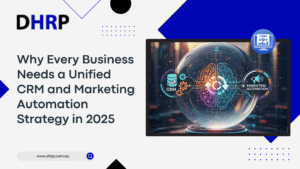When discussing CRM trends 2025, one thing stands out — the growing shift toward unified and AI-driven solutions. According to the studies and statistics on Salesforce, 75% of marketers are implementing AI in their strategies.
Now, what does it have to do with CRM? It relates to the new demand for unified CRM.
The modern CRM isn’t just a system for storing customer data; it also forecasts buying customers, creates lists of potential customers, and automates most of the marketing process.
Of course, your marketing strategy still needs a human touch, but once you have a plan and an AI-powered CRM, you can automate almost everything. Now, why do businesses in Australia need unified CRM? Let’s have a look.
What is a Unified CRM and Marketing Automation Strategy in 2025?
Are your sales, marketing, and service teams working in silos? Do you often struggle to keep customer data consistent across departments?
A unified CRM is all about bringing together your sales, marketing, and service data instead of keeping them in separate, disconnected areas.
When you add marketing automation to that mix, you really get a complete system where everything works together smoothly: leads come in, get nurtured, turn into customers, are serviced, and ultimately retained.
Here are some key points:

- You have shared data throughout the customer lifecycle, which means your CRM isn’t just a simple contact list but a dynamic system that’s always updated.
- You can automate marketing workflows like emails, segmentation, and scoring, all of which link back to the CRM.
- AI plays a role in CRM software by making smart decisions, such as scoring leads, determining the best action, and improving segmentation.
- This strategy also takes into account the costs of implementing the CRM, expected ROI, and the long-term benefits.
- Lastly, don’t forget to think about the difference between on-premise CRM and cloud CRM, since your choice affects flexibility, cost, and scalability.
The Benefits of CRM and Marketing Automation Integration
If your company is still thinking, let us give you the reasons for it:
- Increased efficiency: Having everything in one system cuts down on duplicate entries, manual hand-offs, and separate reporting tasks. Plus, marketing automation ensures leads are nurtured without needing constant manual input.
- Improved customer experience: With a single CRM, it's easier to keep track of customer history, automate personalised journeys, and engage proactively. Plus, AI in CRM software allows for hyper-personalisation and real-time responses.
- Ready for growth: A unified approach positions a business well for scaling, thanks to options like cloud-based CRM, AI insights, or new automation workflows. Looking ahead to 2025, it’s clear that having unified data and integrations is crucial.
- Making data-driven decisions: When marketing, sales, and service teams share data through a CRM, you can develop predictive analytics, figure out what’s working, and optimise for growth.
- Gaining a competitive edge: Since many Australian businesses are still using fragmented systems, transitioning to a unified CRM and marketing automation strategy can really set you apart.
How to Create a Unified CRM and Marketing Automation Strategy
Well, Dynamics 365 is one of the unified CRMs you can get, but as we mentioned, strategy needs a human role. So, here is how to plan it:
1. Define Your Business Goals and Metric-Based Outcomes
- What's the expected CRM Implementation ROI? For example, is the goal to reduce the sales cycle by X% or increase the lead-to-customer conversion rate by Y%?
- What kind of marketing results are you looking for? Maybe better lead nurturing, stronger retention, or cross-selling? It’s important to sync up your marketing automation goals with how you use your CRM.
2. Choose the Right CRM Software & Deployment Architecture
- When choosing between on-premise CRM vs cloud CRM, cloud solutions usually provide quicker setup, lower initial costs, and are easier to scale. This is often better suited for small and medium-sized enterprises (SMEs) in Australia.
- Look into various CRM consulting options, particularly vendors that focus on implementing CRM systems and managing change.
- Ensure your software integrates well with marketing automation tools and includes AI features like lead scoring and predictive analytics.
3. Map Your Customer Journey and Integrate Workflows
- Make sure to highlight the main stages: acquiring new customers, maintaining contact, closing the deal, providing service, and retaining clients.
- Set up workflows: What happens when a lead engages? Which automations kick in? How will the CRM reflect those changes? How do we loop data back into our marketing efforts?
- Get sales and marketing on the same page: use shared dashboards, agree on key performance indicators, and establish smooth hand-off processes.
4. Implement Data Governance and Integration
- First off, make sure to clean up your data before you migrate. This is key to keeping quality and consistency in check.
- Next, figure out how your CRM and marketing automation for business growth will work together; you'll want to share data, set up automated segments, and create feedback loops.
- Lastly, don't forget to follow Australian privacy laws and keep everything compliant.
5. Deploy, Train, and Optimise
- Collaborate with CRM consultants to get the system up and running, train the users, and create the necessary dashboards and reports.
- Keep an eye on important metrics: compare the costs of CRM implementation to the benefits we've seen, track lead conversions, and measure sales pipeline speed.
- Introduce AI in the CRM software step by step: begin with lead scoring, personalise automation, and expand its use as the team becomes more comfortable.
Conclusion
In 2025, businesses can no longer afford disconnected systems. A unified CRM integrated with marketing automation simplifies operations, strengthens customer relationships, and accelerates growth. Through Dynamics 365 CRM implementation, organisations can align sales, marketing, and service under one intelligent system.
Whether it’s improving ROI, enhancing data insights, or automating workflows, a unified CRM delivers measurable impact. Partnering with DHRP, a trusted CRM implementation expert in Australia, ensures seamless deployment and maximum value.
DHRP helps businesses harness Dynamics 365 to stay agile, data-driven, and future-ready in an increasingly competitive market.
FAQs
Because in 2025, customer expectations demand speed and personalisation. A unified CRM connects marketing, sales, and service data, improving collaboration, automating workflows, and enabling smarter decision-making for better customer engagement and long-term growth.
Integrating CRM with marketing automation boosts performance by streamlining lead management, automating nurturing workflows, and aligning teams. It enhances data accuracy, speeds up response times, and helps businesses convert leads into loyal customers efficiently.
Key CRM trends 2025 include AI-powered analytics, predictive insights, hyper-personalisation, and cloud-based scalability. These innovations enable businesses to deliver smarter customer experiences, improve ROI, and maintain a unified, data-driven approach across all operations.



































































































